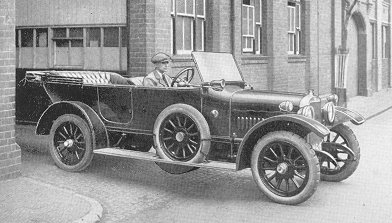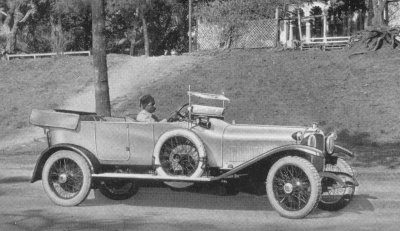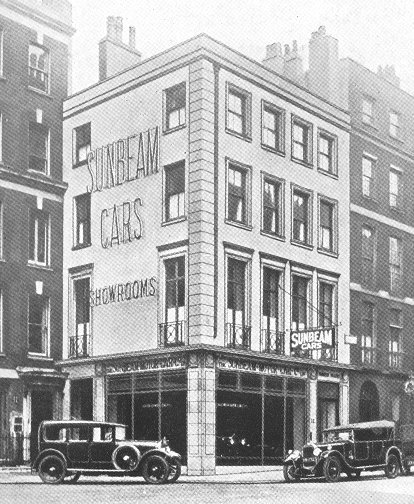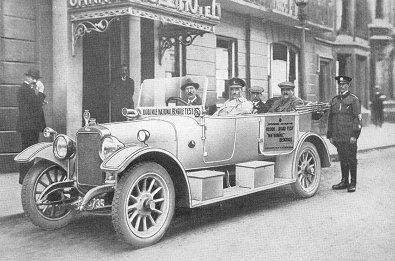|
After the War
The war ended in November 1918 and so
did the Government contracts, it was now back to work as normal at Sunbeam.
Thanks to the company’s technically demanding war work, both on aircraft and
aero engines, Sunbeam now had an extremely skilled workforce. Unfortunately John
Marston passed away in 1918 during a holiday at Colwyn Bay and Thomas Cureton
ably succeeded him as Chairman.
|
| |
|
| Read about
Sunbeam's brilliant design engineer Capt. J. S.
Irving |
 |
| |
|

A 16hp. car at Moorfields.
The first car to leave the works after the end on the war. |
Car production started again
in November 1918 and the company announced that it
would be producing two of its pre-war models, the
16hp. and the 24hp. both however, with improvements.
The 16hp. design would remain in
production in many forms until 1924 and large
numbers were made. It began life in much the same
form as the earlier version with the same side valve
engine. |
|
Several models were available from a
running chassis that sold from £655 to the Cabriolet that was available from
£1,040. About 2,000 were made.
From 1922
onwards the car became the 16/40hp., almost
identical mechanically except for a new overhead
valve engine.
All prices
were reduced by £100 and during 1922 and 1923 a
total of 895 were built.
|
|

A 24hp. Sunbeam car from 1920. |
In 1924 the car went through
another transformation in the form of the 16/50hp.
This featured a 2.54litre, 6 cylinder overhead valve
engine, but only 26 were produced.
The other post-war car, the 24hp.
would also remain in production until 1924, again
with many improvements during its manufacturing
lifetime. |
|
The initial version was similar to the
16hp. but fitted with a 4.5litre, 6 cylinder engine. Several models were
available including the basic running chassis, the Touring Model, the 4-Seater
Sporting Model, the Saloon, the Limousine, the Landaulette and the Cabriolet.
Prices varied from £965 for the chassis to £1,300 for the Saloon, Limousine,
Landaulette, and Cabriolet. A total of about 900 were produced.
From 1922 the car became the 24/60 with
a more powerful overhead valve engine. About 500 were produced. In 1924 the car
went through another transformation with the introduction of the 24/70hp. The
new car had four wheel brakes as standard, and a new efficient gearbox. Prices
varied from £1,060 for the running chassis to £1,625 for the Saloon, Limousine,
Landaulette, and Cabriolet. A total of 102 were built.

The London Showrooms at 12 Princes Street, Hanover Square.
|
|
In 1919 the Automobile Association conducted and important
test over 10,000 miles to determine the relative merits of benzol as a motor
fuel.
A 16hp. Sunbeam car was chosen for the test, and the 10,000 miles were
covered in 62 days, with an average fuel consumption of 24.57m.p.g. After the
test the engine was dismantled and showed no appreciable signs of wear or
damage.
Afterwards the car was sold to a gentleman in Wiltshire. Five years
later he wrote to the company stating that the car had covered 100,000 miles,
with only little attention, and had never let him down.
|

The Sunbeam car that successfully completed the
10,000 miles National Benzole test in 1919. |
|
In 1919 after a wartime ban, trials and racing events were
again held in Europe. A Sunbeam car competed in the famous hill climbing trial
at Gaillon and achieved a new record, covering the 1 in 9 course at an average
speed of 109m.p.h.
Interior
views of the factory in 1919.
|
|
 |
Assembling components. |
|
A corner of the finishing
shop. |
 |
|
 |
Testing engines. |
|
The chassis erecting shop. |
 |
|
 |
Another view of the chassis
erecting shop. |
|
Completed car chassis. |
 |
|
 |
The coach smiths shop. |
|
Another view of the coach
smiths shop. |
 |
 |
|
 |
|
 |
| Return to
The French Connection |
|
Return to
the beginning |
|
Proceed to
Sunbeam, Talbot, Darracq |
|